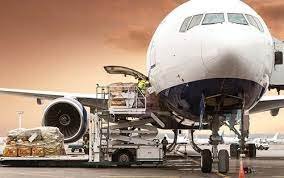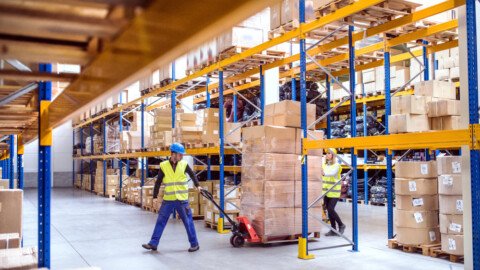2020 is going to go down in history as a year anyone in air freight will particularly want to remember. COVID-19 has driven air-freight traffic to historic levels, resulting in a more enterprising industry and IT technology to propel this industry into a solid and secure future. All these initiative-taking and reactive steps will solidify and result in improved revenue and profit over the long-term future for the air cargo freight industry. And, of course, there are many macroeconomic factors outside the industry’s control which will have a great bearing on 2021, including moving billions of doses of vaccines aboard hundreds of flights in the months ahead, putting underused planes and crews to work while circulating the very medicine that airlines hope will get their lost revenues.
Upamanyu Borah
The year 2020 has been unlike any other for air cargo: the industry has accomplished the notable feat of delivering life-saving goods in response to the COVID-19 pandemic, while reeling from significant capacity groundings. Yet, what comes next will be the biggest challenge to air cargo’s ingenuity in its modern history–– delivering long-awaited COVID-19 vaccines worldwide.
Despite many unknowns, cargo communities worldwide have already started preparing for the event. Indeed, it will take considerable planning and effective coordination between airports and logistics companies to take up such a high-stakes challenge. Over half of global vaccine doses are expected to be transported by air cargo because of its speed and reliability, dictated by global demand and the absence of local production facilities in some countries.
COVID-19: Disruption vs Opportunity
The crisis confronting the aviation industry was not only unprecedented but one-of-a-kind that whosoever working in the industry did not have any clue on how to put operations and the industry back on track. The harm caused by the pandemic was evenly spread between forwarders and airlines, with contracted capacity and sky-high rates. Amidst all these, industry players chased business as hard as they could through the year to militate against low volumes. Finally, there was little succour in the final quarter.
Airlines and leasing firms are rushing to permanently convert older passenger jets into freighters, betting on a boom in e-commerce as the value of used planes tumbled amid the pandemic. This in turn has created a huge opportunity for passenger-to-freighter (P2F) conversion companies. The conversion boom is also helping aviation maintenance, repair and overhaul groups offset some of the lost business from the decline in passenger flights.
It’s expected the number of passenger-to-freight conversions globally will rise by 36 per cent in 2021. The boom in e-commerce is expected to help boost the trend.
Significantly, the P2F conversions are a step beyond the cheaper temporary conversions many airlines have implemented during the pandemic, which remove passenger seats to carry more cargo. Permanent conversions are a financial bet that air freight demand, which was weak before COVID-19, will remain strong for years to come as shoppers turn to e-commerce. The airline industry estimates it will take until 2024 for passenger traffic to recover to 2019 levels.
Normally about half of the world’s cargo is carried in the bellies of passenger planes, but the hit to demand has left the world more reliant on dedicated freighters. Boeing said cargo yields rose by 40 per cent through September because of the pandemic-related passenger disruptions, and it forecasts more than 60 per cent of freighter deliveries over the next 20 years will be conversions rather than new wide-body freighters like the 777. Narrow-body freighters are almost all conversions.
At present, air charter and airline cargo service providers are looking to maximise their customer base by leveraging and optimising their current domestic, international or transatlantic routes, and are marketing expanded services that allow other logistics organisations the options to maintain their contractual obligations and service level commitments to their customers. Organisations looking to procure cargo freight services will have more choice for 24×7 logistics solutions to increase their reach and number of delivery destinations. According to the latest data, while there has been a slight recovery, ‘peak’ is way too strong a word to use for the volumes of the past two months.
Meanwhile, the impact of COVID-19 on cargo operations has resulted in digital transformation initiatives that include enhanced web interfaces to allow more self-service quotes and transactions for cargo shipments and charter services via cargo.com websites. Converting to chartered, cargo-only flights has required the implementation of revenue management to optimise the cargo rates and maximise yields across available inventory in terms of belly space, payload, and containers B2B air freight services.
The air freight supply chain and cargo freight operations, that are experiencing increased volume, have facilitated streamlined processes to improve the management of air freight and carrier paperwork. This involves bill of lading, air waybill, inventory counts, safety documentation for dangerous/hazardous goods, EDI data transmissions to expedite and resolve international customs check points, certificates of origin, etc. Requirements for increased documentation present a great opportunity to provide Electronic Data Interchange or (EDI) and data exchanges support services between shippers and airline carriers.
Additionally, air cargo companies are employing more resources to implement Big Data Thinking Analysis and Artificial Intelligence (AI) to align their future planning on more data-driven analysis and predictive modeling. To meet the global increase in demand, the labour force is trying to address the lack of a skilled workforce and bridge any employee gaps that may cause hindrance in operations or delays in service. Strengthening knowledge in project management methods such as Agile, Extreme Programming, Lean Software Development and DevOps also stands critical to benefit the technology gaps and needs of the air cargo and freight industry in the near future.
Riding out the Storm
Current trends indicate improvement in air cargo prices and full switch to all-cargo chartered flights. Several airline carriers are further reviewing the addition or conversion of A330, A350, 777, 787 and 737 freighters to their fleet and facilitating the process. Carriers with grounded planes are still trying to salvage the situation by taking up cargo operations. Especially now when the fuel prices have plunged, cargo operations can bring in much needed cash.
Additional steps across the industry in this direction include, removing passenger seating from the upper deck cabin to accommodate additional cargo freight space and loading loose cargo on the seats. Further expansions have involved the use of the overhead bin space to assist with the shipment of small packages to maximise revenue by leveraging all available space within the aircraft.
Dedicated air freighters are flying more hours of the day than usual to help make up for the decline in passenger belly space and some airlines are running ‘ghost flights’ without passengers due to attractive cargo rates, but capacity and demand remain mismatched, according to industry experts. The limited capacity and higher rates mean more expensive technology and fashion items would receive higher priority for air shipment than lower value items.
The rising demand led to a renewed climb in air freight rates, which peaked in April and May at a time when passenger capacity bottomed and there was unprecedented demand for masks and other protective gear.
With demand especially high on trans-Pacific routes, major Asian airlines are also benefiting from strong cargo demand, though it is not enough to offset lost passenger revenue. Although off their respective peaks, freight rates across all major routes remain significantly above historical levels, a trend we believe has staying power as passenger airline belly capacity remains largely out of the market.
Embracing newer mechanisms
The impact on the worldwide air cargo logistics industry has been significant and affected the industry’s ability to recover from COVID-19. Utilisation of passenger aircraft, expanded use of the charter flights, demands on the flexibility in bi-lateral and multi-lateral regulations, new standards for operations, protection of personnel– the industry is witnessing new procedures and logistics arrangements almost every day. It’s a big task to collect information and even a bigger one to disseminate it to the right businesses for more uniformity and compatibility.
Beyond regulations, it is clear that industry stakeholders need to learn lessons from what they experienced, and need to implement new procedures within the industry in order to prepare themselves for potential crises in the future – in particular, procedures involving employees and their health and safety. It is essential that the various companies that make up th sector – like other industries – be able to create emergency plans to anticipate this type of crisis. This will involve analysing and managing risks, training employees and implementing pre-established procedures for a quick response (stocking and supplying protective equipment, monitoring staff wellbeing, managing schedules, setting up internal arrangements with emergency teams, managing IT systems to optimise remote working and protecting personal data). For aviation in particular, greater importance needs to be placed on air cargo and on adapted procedures, for example, to maintain activity despite the decline in capacity (running charter flights and adapting aircraft to carry cargo when passenger flights are impossible).
The industry is convinced that there will be a number of changes to the way people work after this crisis, and that air cargo will be able to adapt its procedures. The industry has seen that stakeholders have been able to adapt quickly, but providing and sharing feedback will be essential as they emerge from the crisis so that all businesses can adapt emergency procedures to suit their own activities and better anticipate unprecedented situations, such as this.
The industry is now forced to rely on technology innovations in cloud-based freight software solutions, eFreight solutions, enterprise resource planning (ERP) software, and third-party logistics (3PL) software that integrate real-time, up-to-date cargo data, brokerage, and freight forwarder software. The expansion of air cargo charters and airline freight carrier services has called for additional package and cargo shipment tracking and enhancements via GPS, RFID and Bluetooth technology to assist customers and shippers with transporting and tracking cargo freight. Air cargo carriers now look to host technology advancements such as Open Cargo Platform (OCP) products to provide a workflow-based and virtual portal experience that allows cargo customers to transact electronically. Future trends also points to Bluetooth technology to track and monitor unit load devices (ULDs) – with the addition of Bluetooth sensors installed in cargo warehouses. Cargo warehouses will also begin exploring adding self-service cargo kiosks to enable truck-drivers to self-service and skip cargo counter customer service clerks, thus reducing the manual paperwork processing. This, along with Electronic Data Interchange innovations, will transmit much of the paperwork documentation electronically.
Imperative to work together
Air cargo has historically been the optimal choice for moving high-velocity, high-value goods such as pharmaceuticals but the complex chain of custody invites a range of issues. With more than eight hand-offs before the vaccine reaches the end consumer—including manufacturers, logistics service providers (LSPs), ground handling agents (GHAs), air carriers, last-mile distributors, and medical professionals—the temperature-sensitive COVID-19 vaccines will be subjected to multiple touch points across disparate data collection systems.
Unsurprisingly, preparedness will largely rely on the quality of coordination between cargo stakeholders. This is a concept that the air freight industry embodies on a daily basis. Yet in the case of the Covid-19 vaccines, it will take a greater amount of organisation to work around the ‘moving parts’ affecting planning. Air freight and logistics companies need to work together, but also with pharmaceutical laboratories, specialised industry bodies (Pharma.Aero), hospitals and government agencies tasked with national preparations. In addition, cargo communities will need to reach out to their counterparts in various origins/destinations in the vaccines’ journey. This will ensure precision just-in-time planning for the ‘go live’ and better predictability along the supply chain.
Cargo operators will also need to jointly assess the capabilities available for fast processing of the vaccine shipments. It is critical to evaluate the total cool chain capacity at airports in terms of infrastructure, equipment and labour. Ground handlers and GSSAs should carefully plan ahead and consider exchanging capacity among operators if needed. In the event that capacity is insufficient, cargo operators can consider using temporary freezing units to provide additional capacity – these are already in high demand. Re-purposing other perishables facilities could also be an option. There are other actions that airports can coordinate to manage throughput. These include enabling expedited border control processing, coordinating the right traffic slots for exceptional flights and possibly, extending airfield opening times. The objective should be to ‘flatten the traffic curve’ to the greatest degree and create the right circumstances for seamless flows.
To build on their existing cool chains, airports are reviewing ‘pain points’ along the air freight supply chain and minimise risk for temperature excursions. For instance, shipments are the most vulnerable when waiting while in transit in an uncontrolled environment (such as an airport ramp pre-loading in warm climates). Other risks will no doubt vary across airports and supply chains. Various technologies, such as thermal blankets, could help resolve some of these issues.
We may ultimately come to identify many of the uncertainties around vaccine transport, given time. However, it is critical to start the planning for various conditions. Plans could apply to a range of temperature requirements, scale and predictability of vaccine traffic. Airports should also prepare different planning scenarios according to whether they will act as (regional) distribution points, or as ‘pass-through’ for local demand. Saturation points will vary widely across these scenarios.
Most importantly, data exchange will play a crucial role in these operations; not only in monitoring shipments’ temperature in real-time, but also in coordinating schedules, predicting delays and preventing risks and bottlenecks. Truly, the situation will call for military precision.
In other words, starting from a high-level approach and refine the details over time as more information becomes known. Airports in particular have a central role to play in rallying the air cargo ecosystem around a common goal. For that, airports will need to follow what we term ‘the three Cs’ – coordination, capacity assessment and contingency planning – in order to prepare effectively.
As ever, it is likely to be a combination of luck and strategy that will sort the best from the rest.







